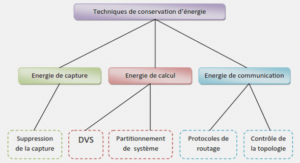The aim of this thesis is to develop an efficient method for the description of observables related to the electronic structure of matter. To validate the approach, we will benchmark it with the existing state–of–the–art theories. Therefore, we will not directly face the comparison with experiments. However, the connection with the experimental world is still of primary importance, as it can guide us on choosing which quantities are important to reproduce theoretically. All the chapters that follow will focus on one particular measurable quantity, the spectral function. This is a key quantity for the interpretation of different crucial experiments, which are based on phenomena that have marked the development of quantum theory itself: the photoelectric effect and quantum tunnelling. Indeed, the diagonal of the spectral function in real space is the fundamental observable for describing scanning tunnelling spectroscopy. Its diagonal in reciprocal space is the cornerstone of angle resolved photoemission spectroscopy. Finally its trace, which is basis independent, is the many–body quantity that is needed for reproducing photoemission and inverse photoemission experiments. Tunnelling spectroscopy is essentially a surface sensitive technique. Also photoemission and its variants, according to the photon energy, are sensitive to the surface. However, they are extremely useful for investigating also the bulk properties of a system. In this thesis we concentrate on the bulk, and photoemission will therefore be our primary reference experiment.
Photoemission experiments are the modern times development of some famous investigations performed by Hertz in 1887, who observed what became known as photoelectric effect: under particular circumstances, a beam of monochromatic light is able to knock out electrons, thus called photoelectrons, from a solid. The quantum theoretical explanation [13] of this effect earned Einstein his Nobel prize: in an independent–particle picture (see fig. 1.1), a photon of frequency ω/2π is absorbed by one of the electrons of the material, with initial energy −εB −φ, where φ is the work function (energy needed to eject an electron from the highest occupied level, namely, in a metal, the vacuum minus the Fermi energy) and εB > 0 is the binding energy of the electron, measured with respect to the Fermi energy µ. If the energy gain ħω is sufficiently large, that is if ħω > εB + φ, the electron escapes the material into the vacuum, with positive kinetic energy εk = ħω− φ − εB and momentum ħk, and is then collected by an analyser.
This effect is at the basis of PhotoEmission Spectroscopy (PES), whose goal is to determine the energy levels of electrons in materials. Since conservation of energy states that −εB = εk − ħω + φ, and since εk is measured by a detector, ħω is chosen by the experimentalist and φ can be known, the electron binding energy can be determined from the kinetic energy of the photoelectron released in the vacuum.
Plotting the intensity of the signal, which is proportional to the number of photoelectrons, as a function of the binding energy, one obtains an extremely rich spectrum, where a series of distinct features reflects the different electronic energy states allowed in the material.
These series of satellites, smaller and smaller as they depart from their quasiparticle, show up to the left of each prominent peak of the photoemission spectrum, in the valence as in the core region. They are not energy levels in the one–particle sense, but they are a clear benchmark of the collective behaviour of the electronic system [1], and they require a full many–body treatment to be theoretically reproduced.
Depending on the system, other mechanisms of energy–loss are possible [16], each resulting in other satellites in the photoemission spectrum.
Furthermore, in a photoemission experiment, other peaks can show up: they are the consequences of additional events like multiple scattering of the photoelectron before escaping the surface, or filling of the photohole left behind. Secondary processes like inelastically scattered electrons or results of “cascade” processes add up in the incoherent background which grows to the left (smaller kinetic energy of the photoelectron) of the most prominent features.
Finally, all spectroscopy techniques that involve electrons are highly surface sensitive. In particular, for kinetic energy of the photoelectron (which is determined by the photon energy and the binding energy range of interest) ranging from 10⁰ to 10³ eV, the corresponding electron inelastic mean free path λe is 4÷40 Å [17], a few lattice constants inside the material. Therefore, in general, the measured electrons stem from a region quite close to the surface. If one wants to probe the bulk, the surface must be as clean and as bulk–like as possible. Still, it will influence the spectra.
|
Table des matières
I INTRODUCTION
1 The experimental starting point
1.1 Photoemission spectroscopy
1.1.1 The photoemission process
1.1.2 Angle Resolved Photo Emission Spectroscopy (ARPES)
1.2 Scanning Tunnelling Spectroscopy
2 The many–body problem
2.1 The system
2.1.1 The Born–Oppenheimer decoupling
2.1.2 The electronic system
2.2 The problem
2.3 Observables
2.4 Reformulations of the problem: functionals
2.4.1 The Rayleigh-Ritz principle
2.4.2 Hohenberg–Kohn Density Functional Theory (DFT)
2.4.3 One–body Reduced Density Matrix Functional Theory (RDMFT)
2.5 Green’s function
2.5.1 Lehmann representation
2.5.2 Analytic properties of the Green’s function: the spectral function
2.5.3 Standard route to the spectral function: the self energy
2.5.4 Dyson and Hedin equations
2.6 The Hubbard model
II Auxiliary systems
3 Auxiliary systems: an introduction
3.1 Reduced quantities
3.2 How to build auxiliary systems
3.2.1 The generalized Sham–Schlüter equation
3.2.2 What we have and what we have not
3.3 The Kohn–Sham system
3.3.1 The Sham–Schlüter equation
3.4 An auxiliary system for the density matrix
3.5 The spectral potential
3.6 DMFT and spectralDFT
4 Auxiliary systems: explicit examples
4.1 The Hubbard model on the Bethe lattice
4.1.1 The auxiliary system
4.2 The symmetric Hubbard dimer
4.2.1 The auxiliary system
4.2.2 Sham–Schlüter equation approach
4.3 The homogeneous electron gas
4.3.1 Real system viewpoint: HSE06 solution
4.3.2 The auxiliary system
III CONCLUSION
![]() Télécharger le rapport complet
Télécharger le rapport complet






